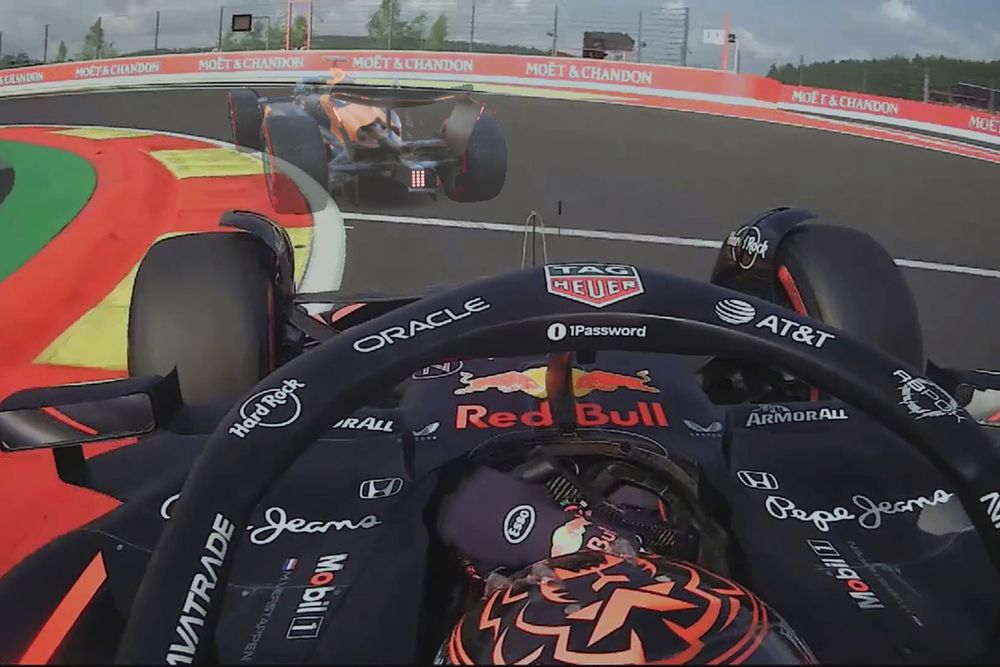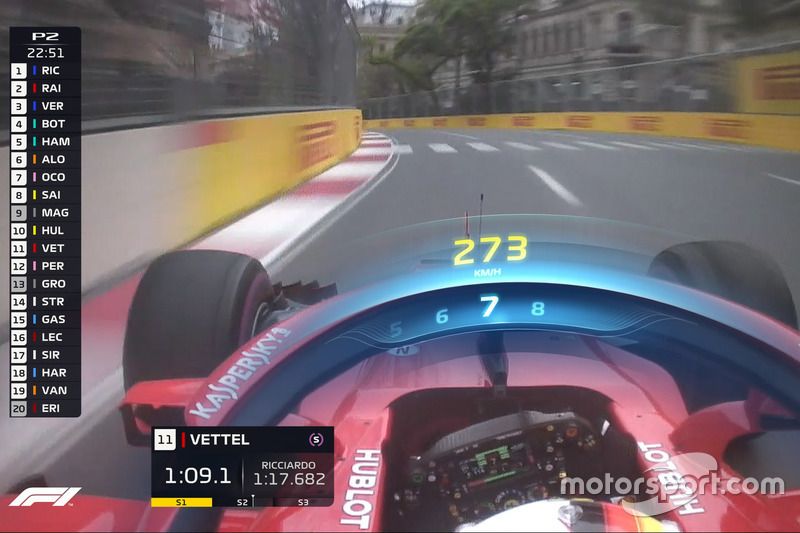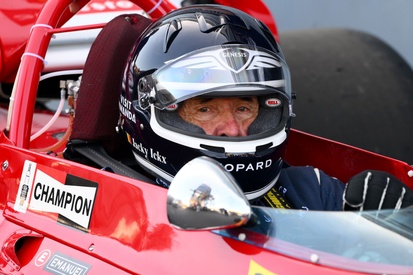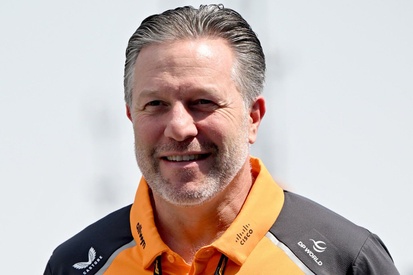How ghost cars tell the story of F1 2025's tiny margins

We’re on board with Lando Norris as he speeds out of Zandvoort’s penultimate corner. Norris looks on course for a crucial pole, until suddenly the airbox of a second McLaren flashes through the screen. Team-mate Oscar Piastri has had a slightly better exit and drifts away from us through the banking final corner onto the main straight, claiming pole by what seem to be inches. The difference between victory and defeat is 0.0012s, and thanks to Formula 1’s new ghost car tool we’re able to visually exactly what that looks like.
Amid the tightest F1 grid ever, the tense Dutch GP qualifying session has been the rule rather than the exception in 2025. Helping make sense of those unfathomably tiny qualifying margins this year is FOM’s latest ghost car tool. By using enhanced GPS and timing data, ghost cars can be overlayed onto replays to compare the performance of two cars, giving a helpful visual indicator of where driver A loses time to driver B, who has taken the best line through a corner or how much a car’s lack of top speed is really costing a driver on the straights.
“In qualifying we’ve got thousandths of a second that are separating four cars, and being able to represent that visually and pictorially is incredibly difficult,” F1’s Director of Broadcast and Media Dean Locke told Motorsport.com. “It is so difficult to understand how amazing some of these laps are, whether that’s Charles Leclerc snatching pole away from the McLarens in Hungary or some of those incredible laps from Max Verstappen. Our target is to explain that story.”
F1 has trialled the ghost car concept in the past, but the biggest hurdle to regularly implementing it was getting the pinpoint accuracy required and being able to deliver it in a timely manner, as qualifying reporting only has a short shelf life before the focus moves on to Sunday’s grand prix.
“It’s always been very difficult to do that quickly after qualifying for the whole of the lap,” Locke explained. “We needed a certain level of accuracy and authenticity if we’re passing this on to all of our broadcast partners. We’ve always known that GPS can be difficult to use in these types of simulations. Whilst we have a lot of confidence in our front and rear positioning of the car on track, our side-to-side positioning is less reliable.
“The reason why we thought we could do it now was that we decided to build a bespoke application to speed up that process and get this out to the broadcast partners and fans promptly after qualifying. With the app we now take in that GPS data and overlay that with video so we first tag the data to the video. Then we cross reference it with onboard cameras to correct any positioning as we go around the lap.
“It’s mostly a manual job by very good editors who are fast and looking at this stuff. The key part that makes it hard is the really accurate reference points. There is actually a tolerance of five percent in horizontal and vertical framing differences on the onboard camera angles. That seems small but it makes such a difference when you’re trying to cross reference data with it. Just a couple of frame dropouts in the onboards can then knock everything out of shape. That’s what the human part is working on. But I do think AI will play a part in that in the future as we keep improving that app.”

F1 Ghost Car tool
Photo by: FOM
The new feature, which is used regularly on F1 TV and the series’ social media channels, has been a big hit with fans, but broadcasters are also enjoying the extra tools at their disposal to dissect qualifying laps.
“There was a really strong reaction to it before the launch,” Locke said. “We discussed it with broadcast partners in advance, to the point of how best to deliver it to them. And sometimes it might not just be about P1 or P2, it could be the difference between P1 and P4 that is editorially relevant. So, we also take some feedback from them.
“It’s being used a lot by a wide range of broadcasters and they’re happy with it. To be recreating that and the top down view, which sometimes works better than the onboard, was something I didn’t think we’d be able to do so quickly.”
F1’s 30-minute target
F1’s broadcast team is continuously chasing improvements by incorporating new technology, with the goal of shaving even more time off the process so the ghost car tool can make it into post-qualifying broadcast shows.
“Actually, some of our broadcast partners have said the time frame works quite well for them, because they can do it in their pre-shows the next day,” Locke said. “But I’d still like to get it out a little bit quicker. We’re probably looking at 90 minutes to two hours at the moment, and there’s still a big target of 30 minutes after those laps are done.
“There’s lots of workflow improvements we can do, like cleaning up in the imagery, which can have a slight jitter in the data right now. And our data team is hoping to further improve GPS data before they transfer it to the media team. That would mean there’s less of a manual approach to it. Latency is one of our biggest hurdles, so processing that data and then using it is a key operational part.”
Providing those visual aids to dissect qualifying isn’t just a boon for die-hard fans, but it also gives the more diverse fanbase F1 is attracting a better way to make sense of just how tight the competition is. Another way to make F1 more accessible to younger generations has been the gamification of graphics, with the heads-up display covering the halo a good example that looks lifted straight out of the F1 video game franchise.

FOM has also experimented with Gyro cameras
Photo by: FOM
“I can’t tell you what the reaction was when we told the TV director, he was about to have a graphic script through the centre of the picture output,” Locke chuckled. “It seemed an incredibly weird thing to do, but it ended up working out really well. Something like the ghost cars really works across the board from the really entrenched fan, who wants to understand who was slightly off the apex, to the casual fan asking why the McLarens didn’t get pole this week.
“We have a real diverse fan base and audience and we don’t want to alienate a hardcore fan opposed to a more casual or newer fan to the sport, so finding these solutions that explain something pictorially that’s quite complex is just an advantage, rather than a commentator or a pundit saying ‘I think it’s at Turn 4’. What does that actually mean?”
No technology for technology’s sake
The days are certainly gone of FOM offering linear outputs to broadcasters, with its own broadcasters and FOM itself now allowing viewers to select their favourite driver’s onboard camera and team radio streams. And as the F1 viewer becomes more and more discerning, Locke and his team continuously look at the next steps to make F1 broadcasting more captivating.
Quite how it will achieve that is a continuous process, as the hectic 24-race schedule doesn’t give a lot of off-season time to experiment with new technology. Therefore, novelties are constantly tested throughout the season instead, with FOM’s recently revamped media and technology centre in Biggin Hill giving the series more flexibility.
“The investment we’ve done into our Media and Technology Centre it just gives us a really agile approach. You’re not shipping equipment out to the track or sending people out to test systems,” Locke said. “Nearly every race we would be testing something, making improvements, or making us just more efficient. And with the number and frequency of races, and the off-season being really short, we have to do that throughout the season. We can’t wait ’til the end of the season.”

F1 soon added TV graphics to the halo after its introduction
Photo by: Formula 1
Expanding on future plans, Locke added: “Allowing some personalisation, even through a linear live broadcast, is a real growth area for us, so watching a Formula 1 race isn’t a 100 percent passive experience.
“We are having really engaging conversations around the content streams of the future and what should we be offering? We’re really lucky that we’ve got some really active and high-end broadcast partners that know what they want from a tier one sport, and good research groups on what our fans want.
“But while emerging technology like AR and VR is important, I think there is sometimes a tendency to do technology for technology’s sake and we’re very careful not to do that. It has to be enriching to our fans and tell the story.”
Working on Apple’s F1 Movie, which has swiftly become a box office hit, was also an eye-opening experience for FOM’s broadcast squad. And it looked long and hard at how it could feed some of that technology back into its own broadcast product, as Locke explained. “Firstly, we were really flattered that they wanted to use so much of our footage and the way we film races. These were the people that made Top Gun: Maverick, an aerial filming movie, telling us they liked our helicopter shots.
“Some of their systems are incredibly difficult to incorporate into a live broadcast, but there are some concepts and ideas that we took on board. We had conversations about whether we could make some of this available in our live broadcast in a sustainable way. It’s a really active relationship that we had with them on what technology we could bring into the sport.”

Filming for Apple’s F1 movie
Photo by: Simon Galloway / Motorsport Images
The all-new technical regulations for 2026, with a bigger emphasis on electric energy deployment and novelties like the Manual Override Mode to replace the outgoing DRS overtaking aid, will also need some explaining. That work is going on now, and the 2026 chassis changes should also provide FOM with a bigger data bandwidth to boost connectivity.
When asked what F1 fans can expect next year, Locke replied: “What I can tell you is that we’re actively in workshops working around what data we will have and what stories we should be telling out of that data.
“We’ve done quite a lot of work of non-live explainers including CGI animations, whether that’s across digital channels or supplied to our broadcasters. We had a discussion group with our broadcasters with their requirements of what we think is relevant and important to explain those stories to our fans.
“We will get better connectivity with the car, which will allow us to do a little bit more than we are doing now.”
In this article
Be the first to know and subscribe for real-time news email updates on these topics







